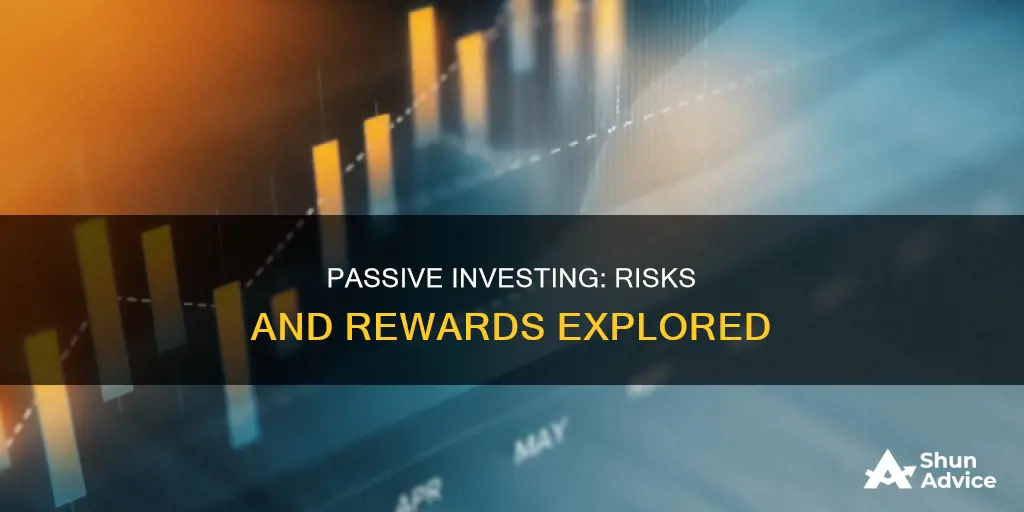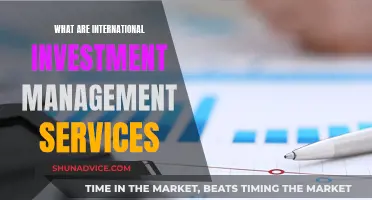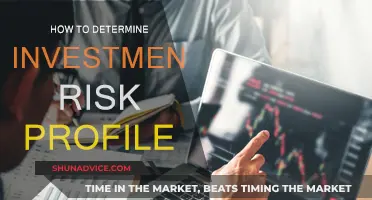
Passive investing is a popular investment strategy that aims to maximise returns by minimising the costs of buying and selling securities. However, despite its benefits, passive investing does carry certain risks. As more investors adopt passive strategies, the market becomes less efficient, and the risk of volatility increases. In this context, passive investors may be exposed to higher risks without the potential for higher returns. This raises the question of whether passive investing is truly a safe option, or if it poses hidden dangers that investors should be aware of.
What You'll Learn

Passive investing may increase market-wide risk
The popularity of passive funds has been rising, attracting investors with the promise of lower costs than active fund managers. Passive investing is an investment strategy that aims to maximise returns by minimising the costs of buying and selling securities. However, passive investing may increase market-wide risk.
Passive investing has been found to contribute to systematic, co-movement-related risk measures. As more investors turn to passive funds, which track indices, the prices of stocks within those indices tend to move in tandem, increasing market-wide risk. This correlated trading affects aggregate risk through a co-movement or systematic channel, rather than a volatility channel. This means that a stock's exposure to passive investing contributes to the systematic (undiversifiable) portion of its risk but not to its non-systematic (diversifiable) portion.
The popularity of passive investing can undo the benefits of diversification and lead to higher market-level volatility. Market volatility has risen since 2000, driven by higher correlations among individual stocks. A study found that explicit passive investing alone could explain a 20% increase in market risk over the last four decades (from 1980 to 2020). The true extent of the effect of index-based investing on market risk will likely be even more significant if implicit indexing is also considered.
Passive investing may also increase the co-movement of liquidity among assets and the odds that assets become illiquid simultaneously. Researchers have found evidence of rising systematic liquidity for US stocks and linked it to the increase in indexed investing.
Computing Investment Gains: Maximizing Your Portfolio Returns
You may want to see also

Passive investing may lead to higher market volatility
Passive investing has become an increasingly popular strategy, particularly in the form of index funds and exchange-traded funds (ETFs). This approach aims to maximise returns by minimising the costs of buying and selling securities, and it often delivers superior after-tax results over medium to long time horizons. However, critics argue that passive investing may lead to higher market volatility.
Passive investing has been criticised for potentially increasing market volatility. A study by UCLA Anderson School of Management associate professor Valentin Haddad and two other US academics found that the rise of passive investing has distorted price signals and pushed up volatility in the US stock market. They observed that passive investors have a "demand elasticity" of zero, meaning they do not adjust their purchases based on stock prices. As a result, an increase in passive investment can push down the market's aggregate elasticity, leading to greater price volatility.
The concentration of passive investment in a handful of key stocks can further contribute to market volatility. With passive investors buying and holding large-cap shares over the long term, the market becomes less responsive to stock prices, resulting in greater price spikes and dips. This dynamic can be observed in the consistently high and growing price-to-earnings (P/E) ratios of large- and mega-cap stocks.
Additionally, the shift towards passive investing has led to a less actively traded market. With fewer active investors, there is a reduction in overall demand elasticity, and mispricing can be more significant and long-lasting. These factors collectively contribute to increased market volatility, as evidenced by the rise in the Cboe volatility index in recent months.
The impact of passive investing on market volatility is particularly notable in the case of the largest firms in the S&P 500. Passive investing strategies tend to track value-weighted indices, resulting in more money flowing into large-cap stocks. This dynamic creates a feedback loop, as the increased demand for mega-firm stocks leaves active investors more exposed to risk, driving up stock prices to convince them to accept that risk.
In conclusion, while passive investing offers benefits such as lower fees and simplicity, it may also contribute to higher market volatility. The concentration of passive investment in certain stocks, reduced responsiveness to stock prices, and the resulting impact on overall demand elasticity collectively contribute to this increased volatility.
Investment Management: The Buy Side Advantage
You may want to see also

Passive investing may reduce the efficiency of the stock market
Passive investing is a strategy that aims to maximise returns by minimising the costs of buying and selling securities. It is typically done by investing in a mutual fund or exchange-traded fund (ETF) that mimics the index's holdings. While passive investing has its benefits, it is not without risks. One of the potential risks of passive investing is that it may reduce the efficiency of the stock market.
Passive investing has gained popularity in recent years, with investors attracted by the promise of lower costs compared to active management. As a result, there has been a massive shift in the global asset-management industry, with investors moving trillions of dollars from active investment strategies to passive or indexing strategies. This shift has sparked concerns about its potential impact on financial stability, including effects on asset prices, volatility, market liquidity, and price discovery.
One of the main concerns is that passive investing may lead to a reduction in market efficiency. As more investors flock to passive funds that track indices, the prices of stocks within those indices tend to move in tandem, increasing market-wide risk. This correlated trading among passive funds can lead to higher correlations among stocks and increased market volatility. Academics have found that passive investing contributes to systematic, co-movement-related risk measures while being unrelated or negatively related to non-systematic, idiosyncratic movements. This means that passive investing can undo the benefits of diversification and lead to higher market-level volatility.
The impact of passive investing on market risk is significant. A research paper by Lily H. Fang, Hao Jiang, Zheng Sun, Ximing Yin, and Lu Zheng found that explicit passive investing alone could explain a 20% increase in market risk over the last four decades (from 1980 to 2020). The true extent of the effect of index-based investing on market risk is likely to be even more significant when implicit indexing is also considered.
Furthermore, passive investing may affect the efficiency of the stock market by altering the information structure and efficiency in the price discovery process. Idiosyncratic price moments are considered essential signals for firm-specific information. However, with the rise of passive investing, the benefits of diversification may be undone, and the information structure in the price discovery process may be altered.
In addition, passive investing may impact the efficiency of the stock market by increasing the comovement of returns and liquidity among assets. This "excess comovement" may be driven by passive managers buying or selling stocks of all index members simultaneously to maintain exposure to the index. As a result, the impact of shocks to asset markets may be broadened, affecting the efficiency of the stock market.
While passive investing can reduce costs and provide diversification benefits, it may also reduce the efficiency of the stock market by increasing market-wide risk, altering the information structure, and increasing the comovement of returns and liquidity. These risks should be carefully considered by investors when deciding between passive and active investment strategies.
Smart Strategies to Turn $50K into $1 Million
You may want to see also

Passive investing may result in smaller short-term returns
Passive investing has become an increasingly popular strategy, with investors pouring money into ETFs that hold many of the same stocks. This strategy has gained traction due to the premise that active managers rarely outperform indices, and investing in mutual funds is more costly than it is worth. However, one of the risks of passive investing is that it may result in smaller short-term returns.
Passive investing aims to cut the costs of deciding which securities to invest in by simplifying the portfolio construction process and reducing fees associated with frequent trading. While this approach can lead to superior after-tax results over medium to long time horizons, it may not always generate the highest returns in the short term.
One reason for this is that passive investing strategies often take a long-term, buy-and-hold approach, avoiding frequent trading to reduce transaction fees and taxable capital gains. This means that passive investors are less likely to profit from short-term price fluctuations or market timing. Instead, they rely on the market's historical pattern of posting positive returns over time, expecting this trend to continue in the long run.
Additionally, passive investing strategies typically aim to replicate market performance by constructing well-diversified portfolios of stocks. While this diversification can help manage risk, it may also result in smaller short-term gains compared to more targeted active investing strategies.
Furthermore, passive funds are limited to a specific index or set of investments and are typically allowed to make few changes. This lack of flexibility can hinder their ability to adapt to market changes and make strategic decisions, potentially resulting in smaller short-term returns.
Another factor contributing to smaller short-term returns in passive investing is the potential for higher market-level volatility. As more investors flock to passive funds, the prices of stocks within those indices tend to move more in tandem, increasing overall market risk. This correlated trading can lead to higher co-movement or systematic risk among stocks, which can amplify market volatility.
In summary, while passive investing can be a successful strategy over the long term due to its cost-effectiveness and diversification benefits, it may result in smaller short-term returns compared to active investing. Passive investors need to be aware of the potential for lower short-term gains due to the inherent limitations and risks associated with this investment strategy.
Futures and Options: A Guide to Investing in India
You may want to see also

Passive investing may increase the risk of fire sales
Passive investing has been one of the most significant trends in the asset management industry over the past two decades. However, it does come with certain risks. One of the dangers of passive investing is that it may increase the risk of fire sales.
Passive investing involves investors blindly pouring money into exchange-traded funds (ETFs) that hold many of the same stocks. Passive funds track the performance of a particular market or index, such as the S&P 500 or FTSE 100, and are typically operated automatically, reducing their running costs. The popularity of passive funds is growing, attracting investors with the promise of much lower costs than actively managed funds.
However, passive investing may increase the risk of fire sales in several ways. Firstly, passive funds are subject to market risk. When the prices of stocks, bonds, or other securities in an index fall, so do the share prices of index funds that track those securities. This can lead to a situation where investors rush to redeem their shares in the fund, causing a further drop in the fund's share price.
Secondly, passive funds have limited flexibility. Fund managers are usually prohibited from taking defensive measures such as reducing their position in shares of particular securities, even if they anticipate a decline in those share prices. This lack of flexibility can result in passive funds being forced to sell assets at a loss during periods of market stress, contributing to a fire sale.
Additionally, the growth of passive investing strategies, such as leveraged and inverse ETFs, can amplify price volatility. These products require trading in the same direction as recent market moves, leading to simultaneous buying or selling pressure that can exacerbate price swings.
Furthermore, the increased concentration in the asset management industry due to the shift to passive management can also increase the risk of fire sales. Larger passive-oriented asset management firms may face higher risks from idiosyncratic events, such as cybersecurity breaches, which could trigger massive redemptions and lead to destabilizing fire sales.
While passive investing offers benefits such as lower costs and simplicity, it is essential to be aware of the potential risks involved, including the increased possibility of fire sales. Investors should carefully consider these risks before deciding between passive and active investment strategies.
Creating an Investment LLC: A Step-by-Step Guide
You may want to see also
Frequently asked questions
Passive investing is subject to market risk. When the market falls, so do the share prices of passive funds. Passive funds are also inflexible and are prohibited from using defensive measures such as reducing a position in shares of particular securities. They are also exposed to higher market-level volatility due to the rise in correlated trading by passive funds.
Active investing involves investors actively hunting for investments and paying higher fees for research and fund management. Passive investing, on the other hand, aims to cut costs by simplifying the portfolio construction process and reducing fees from frequent trading. Passive funds are typically operated automatically and have lower running costs than active funds.
Passive investing is less expensive and complex than active investing and often produces superior after-tax results over medium to long time horizons. Passive investing is also more tax-efficient and simpler to implement and understand than active investing.







